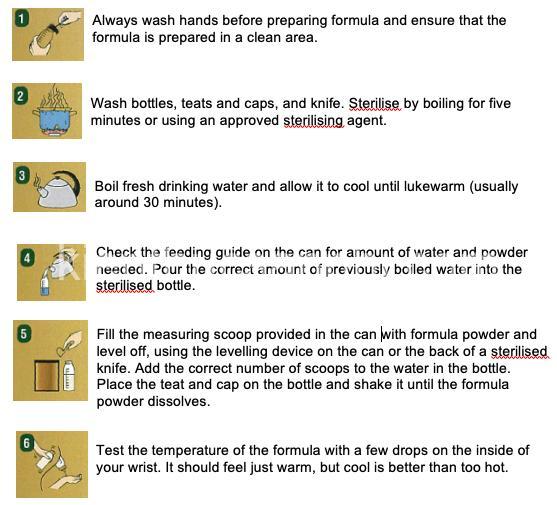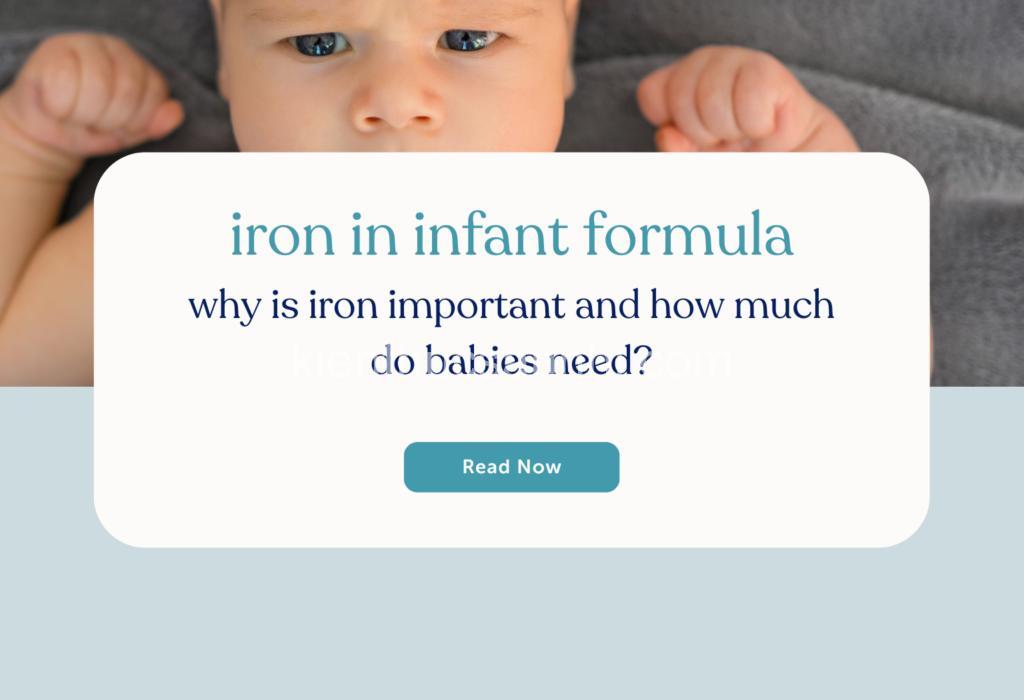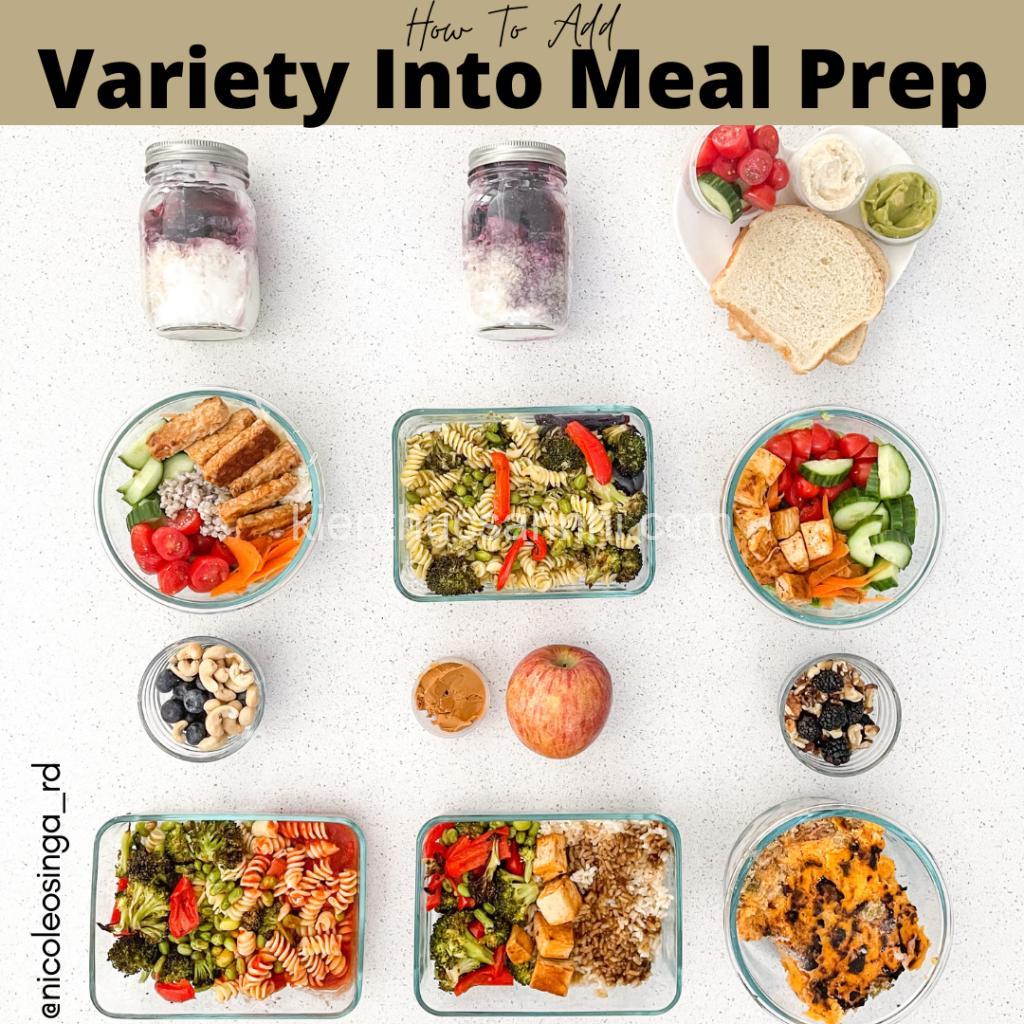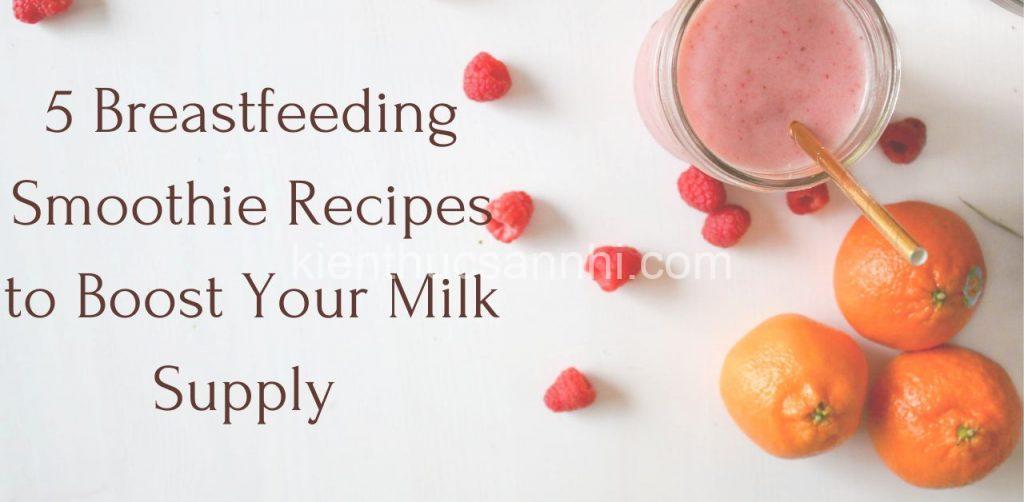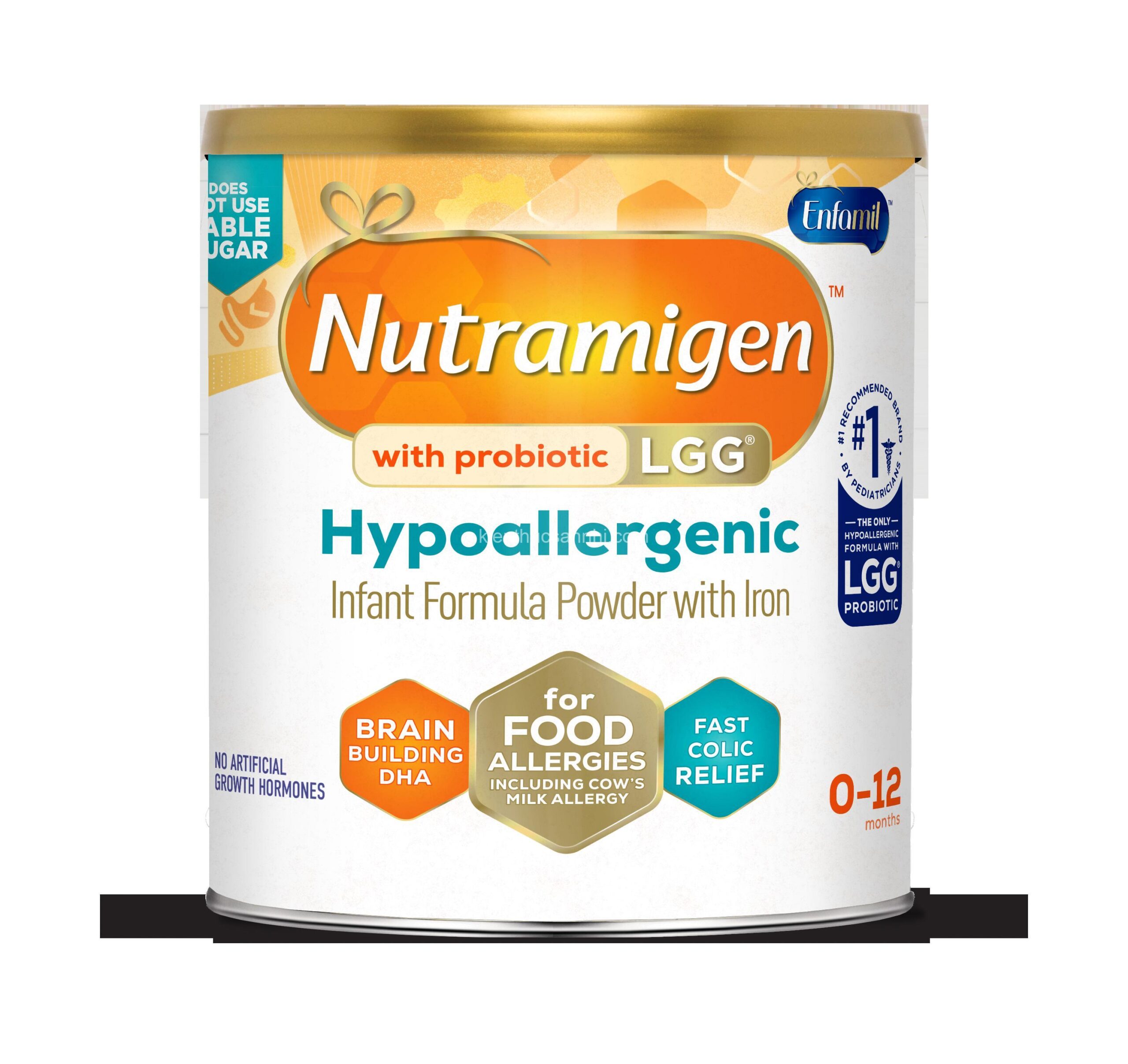
Hypoallergenic Formulas for Babies with Allergies: Guide for Parents. In today’s article, kienthucsannhi.com will explore with you in the most detailed and complete way. See now!
Understanding Hypoallergenic Formulas for Babies with Allergies
Hypoallergenic formulas are specially designed to minimize the risk of allergic reactions in babies. They are formulated to reduce or eliminate common allergens like cow’s milk protein and soy protein. These formulas are crucial for babies who have trouble digesting regular infant formulas, leading to symptoms like eczema, vomiting, diarrhea, and wheezing.
There are three main types of hypoallergenic formulas, each with its own level of protein breakdown:
- Partially hydrolyzed formulas break down milk protein into smaller pieces, making it easier to digest.
- Extensively hydrolyzed formulas further break down protein into even smaller pieces, suitable for babies with more severe allergies.
- Amino acid-based formulas completely break down protein into its individual amino acids, ideal for babies with the most sensitive stomachs.
Hypoallergenic formulas offer several benefits for babies with allergies, including:
- Reducing allergy symptoms by minimizing the amount of allergen your baby consumes.
- Promoting healthy growth and development by providing the necessary nutrients for growth.
- Helping to build a healthy immune system, potentially reducing the likelihood of developing other allergies later in life.
However, there are also some potential drawbacks to consider:
- Hypoallergenic formulas may have a different taste than regular formulas, which could affect your baby’s acceptance of the formula.
- Some babies may experience digestive issues, such as constipation or gas, when switching to a hypoallergenic formula.
- Hypoallergenic formulas are typically more expensive than regular formulas.

Choosing the Right Hypoallergenic Formula
Selecting the appropriate hypoallergenic formula for your baby requires careful consideration. Here’s a guide to help you make the right choice:
- Consider your baby’s age and specific allergy(ies): Different formulas are designed for different ages and allergies. For example, a formula for a newborn with a cow’s milk protein allergy will differ from a formula for a toddler with a soy protein allergy.
- Assess the severity of your baby’s allergy symptoms: If your baby has mild symptoms, a partially hydrolyzed formula might be sufficient. However, for severe allergies, an extensively hydrolyzed or amino acid-based formula may be necessary.
- Pay attention to potential side effects and tolerance: Some babies might experience digestive discomfort with certain hypoallergenic formulas.
- Factor in the cost and availability of the formula: Hypoallergenic formulas can be more expensive, and some might be harder to find than regular formulas.
It’s crucial to consult your pediatrician or allergist for personalized recommendations. They can assess your baby’s individual needs and guide you towards the best feeding option. They may also discuss alternative feeding options like breast milk donation or special medical formulas.
Popular Hypoallergenic Formula Options
Several reputable brands offer hypoallergenic formulas, each with its unique features. Here are a few popular options:
- Enfamil: Enfamil Gentlease is designed for fussy or gassy babies, while Enfamil Nutramigen is for babies with cow’s milk protein allergies.
- Similac: Similac Alimentum is specifically formulated for babies with cow’s milk protein allergies, and Similac Total Comfort is for babies with multiple sensitivities.
- Gerber: Gerber Good Start Soothe is for fussy or gassy babies, and Gerber Good Start Gentle is for babies with milk protein sensitivities.
There are also other trusted brands available, like Earth’s Best and Bobbie. Each formula is tailored to specific allergies and needs, so it’s essential to choose the one that best suits your baby’s situation.
Tips for Managing Allergies in Babies
Managing allergies in babies requires a proactive approach. Here are some helpful tips:
- Safe introduction of solid foods: Introduce new foods gradually and monitor your baby closely for any signs of allergy.
- Creating a safe and allergy-friendly home environment: Minimize exposure to allergens in your home by keeping it clean, dusting regularly, and choosing allergy-friendly cleaning products.
- Monitoring for allergy symptoms: Keep a close eye on your baby for symptoms like eczema, vomiting, diarrhea, or wheezing.
FAQs About Hypoallergenic Formulas for Babies with Allergies
What are the most common symptoms of allergies in babies?
The most common symptoms of allergies in babies include eczema, vomiting, diarrhea, and wheezing. If your baby experiences any of these symptoms after consuming infant formula, it’s essential to consult with your pediatrician or allergist.
How do I know if my baby has a milk or soy protein allergy?
Diagnosing a milk or soy protein allergy typically involves a comprehensive assessment by your pediatrician or allergist. They may conduct allergy testing, such as skin prick tests or blood tests, to determine the presence of specific allergies.
What are the best resources for finding information about baby allergies?
You can find reliable information about baby allergies from reputable organizations such as the American Academy of Pediatrics (AAP), the American College of Allergy, Asthma & Immunology (ACAAI), and the Food Allergy Research & Education (FARE).
Can I switch my baby from regular formula to a hypoallergenic formula without consulting a doctor?
No, it’s crucial to consult with your pediatrician or allergist before switching your baby to a hypoallergenic formula. They can assess your baby’s individual needs and guide you towards the best feeding option.
How can I find a hypoallergenic formula that my baby will enjoy?
While some babies might have a preference for certain hypoallergenic formulas, it’s important to remember that taste can be subjective. Some babies may prefer formulas with sweeter flavors, while others might enjoy those with a more neutral taste.
Conclusion
Choosing the right hypoallergenic formula for your baby with allergies is a critical step in ensuring their healthy growth and development. It’s crucial to understand the different types of formulas available, the benefits and potential drawbacks, and the importance of seeking professional advice from your pediatrician or allergist.
If you have questions about *hypoallergenic formulas or managing allergies in babies, please feel free to leave a comment below. You can also learn more about baby care and other related topics by visiting my website, kienthucsannhi.com. Let’s create a safe and healthy environment for our little ones!*
Entities – Attributes – Values (EAV):
- Entity: Hypoallergenic Formula, Attribute: Type, Value: Partially Hydrolyzed, Extensively Hydrolyzed, Amino Acid-Based
- Entity: Hypoallergenic Formula, Attribute: Allergen, Value: Cow’s Milk Protein, Soy Protein
- Entity: Baby Allergy, Attribute: Symptoms, Value: Eczema, Vomiting, Diarrhea, Wheezing
- Entity: Hypoallergenic Formula, Attribute: Taste, Value: Sweet, Neutral
- Entity: Hypoallergenic Formula, Attribute: Cost, Value: High
- Entity: Hypoallergenic Formula, Attribute: Availability, Value: Online, Retail Stores
- Entity: Baby, Attribute: Age, Value: Newborn, Infant, Toddler
- Entity: Baby, Attribute: Health Condition, Value: Premature, Healthy, Illness
- Entity: Pediatrician, Attribute: Role, Value: Diagnose allergies, recommend formulas
- Entity: Allergist, Attribute: Role, Value: Manage allergies, perform allergy tests
- Entity: Hypoallergenic Formula, Attribute: Ingredients, Value: Hydrolyzed Protein, Amino Acids, Prebiotics, Probiotics
- Entity: Hypoallergenic Formula, Attribute: Packaging, Value: Powder, Ready-to-feed
- Entity: Hypoallergenic Formula, Attribute: Storage, Value: Refrigerated, Room Temperature
- Entity: Hypoallergenic Formula, Attribute: Safety, Value: FDA-approved, allergy-tested
- Entity: Baby, Attribute: Weight, Value: Underweight, Normal Weight, Overweight
Entity – Relation – Entity (ERE):
- Entity: Hypoallergenic Formula, Relation: Contains, Entity: Hydrolyzed Protein
- Entity: Baby, Relation: Has, Entity: Milk Protein Allergy
- Entity: Pediatrician, Relation: Recommends, Entity: Hypoallergenic Formula
- Entity: Hypoallergenic Formula, Relation: Aids, Entity: Digestion
- Entity: Baby, Relation: Experiences, Entity: Allergy Symptoms
- Entity: Hypoallergenic Formula, Relation: Is Available, Entity: Retail Stores
- Entity: Baby, Relation: Has, Entity: Food Sensitivity
- Entity: Hypoallergenic Formula, Relation: Reduces, Entity: Allergy Symptoms
- Entity: Allergist, Relation: Performs, Entity: Allergy Testing
- Entity: Hypoallergenic Formula, Relation: Is Used For, Entity: Infant Nutrition
- Entity: Baby, Relation: Has, Entity: Soy Protein Allergy
- Entity: Hypoallergenic Formula, Relation: Is Made By, Entity: Formula Brand
- Entity: Hypoallergenic Formula, Relation: Is Classified As, Entity: Medical Food
- Entity: Hypoallergenic Formula, Relation: Provides, Entity: Essential Nutrients
- Entity: Hypoallergenic Formula, Relation: Is Suitable For, Entity: Specific Allergies
- Entity: Baby, Relation: Has, Entity: Digestive Issues
- Entity: Hypoallergenic Formula, Relation: Is Designed To, Entity: Reduce Allergy Symptoms
- Entity: Hypoallergenic Formula, Relation: Comes In, Entity: Different Packaging
- Entity: Hypoallergenic Formula, Relation: Is Available In, Entity: Different Flavors
Semantic Triples:
- Subject: Hypoallergenic Formula, Predicate: Is A Type Of, Object: Infant Formula
- Subject: Baby, Predicate: Has, Object: Food Allergy
- Subject: Pediatrician, Predicate: Recommends, Object: Hypoallergenic Formula
- Subject: Hypoallergenic Formula, Predicate: Helps, Object: Reduce Allergy Symptoms
- Subject: Hypoallergenic Formula, Predicate: Is Made With, Object: Hydrolyzed Protein
- Subject: Hypoallergenic Formula, Predicate: Is Available In, Object: Powder Form
- Subject: Hypoallergenic Formula, Predicate: Provides, Object: Essential Nutrients
- Subject: Hypoallergenic Formula, Predicate: Is Suitable For, Object: Babies With Milk Protein Allergy
- Subject: Hypoallergenic Formula, Predicate: Is Made By, Object: Various Formula Brands
- Subject: Hypoallergenic Formula, Predicate: Is Considered, Object: Medical Food
- Subject: Baby, Predicate: Has, Object: Digestive Issues
- Subject: Hypoallergenic Formula, Predicate: Is Designed To, Object: Promote Healthy Digestion
- Subject: Hypoallergenic Formula, Predicate: Comes In, Object: Different Packaging Sizes
- Subject: Hypoallergenic Formula, Predicate: Is Available At, Object: Pharmacies
- Subject: Hypoallergenic Formula, Predicate: Is Available In, Object: Ready-to-feed Form
- Subject: Hypoallergenic Formula, Predicate: Is Generally, Object: More Expensive Than Regular Formulas
- Subject: Hypoallergenic Formula, Predicate: Is Subject To, Object: FDA Regulations
- Subject: Hypoallergenic Formula, Predicate: Should Be, Object: Stored Properly
- Subject: Hypoallergenic Formula, Predicate: Is Not, Object: A Substitute For Breast Milk
